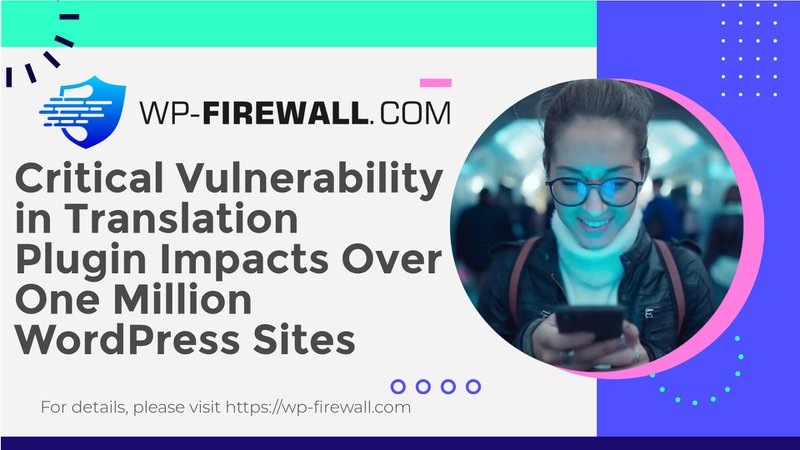
了解最近的 WordPress 翻譯外掛漏洞:安全角度
介紹
WordPress 生態系統龐大且充滿活力,數以百萬計的網站依賴各種外掛程式來增強功能和使用者體驗。然而,這種對第三方外掛程式的依賴可能會讓網站面臨漏洞,最近的一份報告強調了一個流行的 WordPress 翻譯外掛程式存在重大安全缺陷,影響了超過一百萬個網站。在本文中,我們將深入研究此漏洞的詳細資訊、其對網站安全的影響,以及如何保護您的 WordPress 網站免受類似威脅。
漏洞曝光
根據《搜尋引擎雜誌》的報告,該漏洞源自於廣泛使用的翻譯插件,該插件允許網站所有者提供多語言內容。該漏洞被確定為潛在的遠端程式碼執行(RCE)漏洞,這意味著攻擊者可以利用它在受影響的網站上執行任意程式碼。此類漏洞尤其令人擔憂,因為它可能導致整個網站受損、資料外洩以及對敏感資訊的未經授權的存取。
什麼是遠端程式碼執行?
遠端程式碼執行是一種安全漏洞,允許攻擊者從遠端位置在目標系統上執行惡意程式碼。這可能會導致各種惡意活動,包括:
- 資料竊盜: 存取和竊取敏感用戶數據,例如個人資訊和付款詳細資訊。
- 網站污損: 改變網站的外觀或內容以誤導訪客或促進惡意活動。
- 惡意軟體分佈: 使用受感染的網站向毫無戒心的訪客分發惡意軟體。
對 WordPress 用戶的影響
在廣泛使用的插件中發現此類漏洞清楚地提醒人們與第三方軟體相關的潛在風險。對於 WordPress 用戶來說,這事件凸顯了幾個關鍵的考量:
1. 定期更新的重要性
降低漏洞風險最有效的方法之一是確保所有外掛程式、主題和 WordPress 核心定期更新。開發人員經常發布更新來修補安全漏洞,而未能套用這些更新可能會使您的網站面臨已知威脅。
2. 明智地選擇插件
並非所有插件都是一樣的。為您的 WordPress 網站選擇外掛程式時,請考慮以下因素:
- 名聲: 尋找在 WordPress 社群中獲得正面評價和良好聲譽的外掛程式。
- 積極發展: 選擇由開發人員積極維護和更新的插件。
- 安全審核: 考慮已經過安全審核或有及時漏洞揭露歷史的插件。
3. 實施安全最佳實踐
除了保持插件更新之外,網站所有者還應該採用全面的安全策略,其中包括:
- 定期備份: 定期備份您的網站,以確保您可以在威脅發生時快速復原。
- 使用者存取控制: 將使用者存取權限僅限於需要的人,並定期檢查使用者權限。
- 強密碼和雙重認證: 實施強密碼策略並考慮實施雙重認證以提高安全性。
Web 應用程式防火牆 (WAF) 的作用
Web 應用程式防火牆 (WAF) 是一種非常寶貴的工具,可保護您的 WordPress 網站免受上述漏洞的侵害。 WAF 可作為您的網站和潛在威脅之間的屏障,在惡意流量到達您的網站之前將其過濾掉。
使用 WAF 的好處
- 即時威脅偵測: WAF 可以即時識別並阻止可疑活動,從而在攻擊造成損害之前對其進行預防。
- 防範 OWASP 十大漏洞: 強大的 WAF 旨在緩解 OWASP 列出的最常見的 Web 應用程式漏洞,包括 SQL 注入、跨站點腳本 (XSS) 等。
- 減少伺服器負載: 透過過濾掉惡意請求,WAF 可以幫助提高您的網站和#x27;的效能並減少伺服器負載。
案例研究:漏洞的影響
要了解此類漏洞對現實世界的影響,請考慮一個假設場景,其中涉及使用受影響翻譯外掛程式的小型電子商務網站。發現漏洞後,網站所有者疏忽更新插件,導致惡意攻擊者成功發動攻擊。
襲擊的後果
- 資料外洩: 攻擊者獲得了客戶資料的存取權限,包括姓名、地址和付款資訊。
- 名譽損害: 客戶對該網站失去了信任,導致銷量下降和負面評論。
- 財務損失: 網站所有者面臨潛在的法律後果以及與補救和恢復相關的費用。
這種情況強調了主動安全措施的重要性以及網站所有者隨時了解潛在威脅的必要性。
如何保護您的 WordPress 網站
1. 隨時了解狀況
定期監控與 WordPress 外掛和主題相關的安全新聞和更新。訂閱安全新聞通訊並關注信譽良好的來源,以隨時了解最新的漏洞和最佳實踐。
2. 定期進行安全審核
定期對您的網站進行安全審核,以識別潛在的漏洞。這可能包括檢查過時的外掛程式、弱密碼和錯誤配置的設定。
3. 使用安全插件
除了 WAF 之外,還可以考慮使用提供惡意軟體掃描、登入保護和防火牆功能等功能的安全插件。這些工具可以為您的 WordPress 網站提供額外的安全層。
4. 教育你的團隊
如果您有一個團隊管理您的 WordPress 網站,請確保他們接受有關安全最佳實踐的教育。舉辦培訓課程,以提高對常見威脅以及如何緩解這些威脅的認識。
結論
最近流行的 WordPress 翻譯外掛程式中的漏洞提醒我們網站安全的重要性。透過隨時了解情況、實施最佳實踐並利用安全解決方案,您可以大幅降低受到損害的風險並保護您的 WordPress 網站免受潛在威脅。
立即採取行動
為了確保您的 WordPress 網站保持安全,請考慮註冊 WP-Firewall 的免費方案。我們全面的安全解決方案旨在保護您的網站免受本文中討論的漏洞的影響。不要等到為時已晚——立即訪問以保護您的網站 WP-防火牆免費規劃.
引用:
[1] https://wp-firewall.com
[2] https://www.searchenginejournal.com/wordpress-translation-plugin-vulnerability-affects-1-millio

